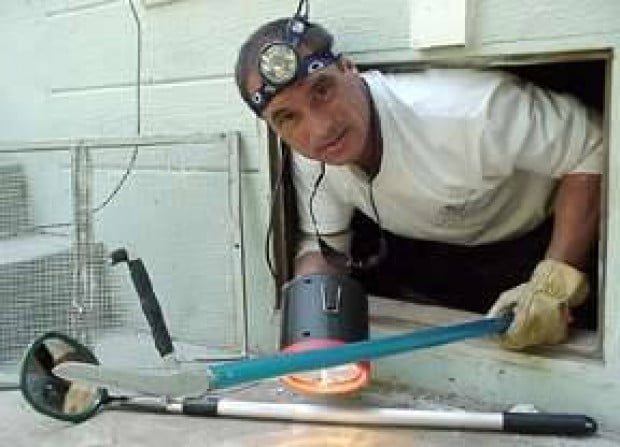Three dogs were bitten in the region in the past few weeks when they ventured too close to rattlesnakes. The dogs had to be rushed to the vet but they were saved when antivenin was provided quickly.
And recently, a 4-foot rattler was found near Pacific Coast Highway in the Point Dume area and an 18-inch rattler was also seen sunning itself on the back porch of a home in Latigo Canyon.
Cathy Goldberg, whose dog, Sparky, was bitten recently, recounted the accident.
“We didn’t know what was wrong with her. Her face was puffy and she was bitten on her lower jaw. So we took her to the vet and they told us she had a rattlesnake puncture.”
Once the dog was back home, the Goldbergs called Bo Slyapich, a professional rattlesnake wrangler who clears the sinuous serpents from properties and movie sets.
“We called him because we have three children and we wanted to keep them safe,” said Goldberg. “He was really thorough and informative, showing us problem areas that we can deal with.”
Slyapich said most of his calls come after a family member or pet has been bitten, but he hopes to help people prevent these accidents in the future by clearing properties before an accident takes place.
Slyapich, who captures and relocates the venomous creatures, said he enjoys the challenges of his job.
“Every time is different and the adrenaline is pumping,” said Slyapich, who was in the stunt business and collected marine specimens, specializing in the gathering of baby sharks for the aquarium trade before making a living at snake wrangling.
This unusual professional aspiration began early on. At the age of five, when many are content with Play-Doh or drawing with crayons, Slyapich was out catching snakes.
Growing up in Malibu Canyon, he gathered nonvenomous California snakes, selling them to pet stores to earn money.
It was not until eight years ago that he started making a living at it in the entertainment industry, by clearing filming sites prior to the arrival of the crew.
Before a crew goes out, Slyapich also gives a safety talk, letting them know what to watch for. “As long as you can see where your feet or hands are going, you’re safe,” he says.
Slyapich partners up with his father, Sam, when he goes on dangerous jobs. “He is the only person who I can trust,” said Slyapich.
Recently, Slyapich broadened his services, clearing ranches and backyards prior to holiday barbecues and clearing properties for real estate agents before a home is sold.
“I fell into doing the private sector after a doctor’s son was bit in January,” he said, realizing that there was a demand for this special trade. The one-and-a-half-year-old child went to intensive care after he was poisoned, but he fully recovered.
However, even when an area is cleared, there is no guarantee that snakes won’t return. Education is key. “I will sit and talk with the client, advising of what signs to look for,” said Slyapich.
The busy seasons for snakes are early spring and late fall, before and after they hibernate. They are also outside during the summer and generally hide in the shade to change their temperature, depending on a certain body temperature to survive.
In the heat of the day, they can hide behind washing machines in a garage or in woodpiles. They may lurk in a crawling space and they love to be under homes.
Over the years, snakes have become more problematic because people are moving into areas where the serpents live.
But snakes are not on the offensive. They will only bite to protect themselves when they feel threatened.
As they hike, people can avoid encountering rattlers if they walk heavy. “Take a stick and make lots of noise,” said Slyapich. Rattlers have no ears, but they can feel vibrations through the ground.
If someone sees a snake, the best way to avoid bites is to stay clear from the animal. “A snake can hit anywhere from a quarter to half of its length,” explained Slyapich.
Aside from dogs and people, horses are also curious and at risk of being bitten. If bitten in the face, a horse will suffocate unless they get immediate help.
“Keep a piece of four-inch garden hose in the barn or ranch and if a horse gets bit, put it up the nasal passage to keep the passage open until the vet arrives,” advised Slyapich.
But if a child or a dog is attacked, the only response should be to bring them to the doctor or veterinarian as quickly as possible. “Do not suck the poison out, cut it or put on a tourniquet, just bring them to the vet or doctor,” he cautioned.
The amount of time available before the bite becomes deadly is not precise because it depends on the amount of venom discharged and where a person or pet was bitten.
In many cases, people first call the fire department, animal control or the sheriff’s department about a snake problem. However, these departments do not conduct extensive searches because of time constraints.
“They give me the calls that they don’t want to handle,” said the wrangler.
The cost of hiring a snake wrangler depends on the danger and how far Slyapich has to drive and how much acreage he has to clear.
Despite his expertise with snakes, the risks of being bitten do exist and Slyapich said he has contacted local hospitals to be sure that they do have antivenin available should it happen.
Despite their undesirability, rattlers do have a purpose–they keep the rodent population down. “I do not believe in destroying the rattlesnake. I try to capture it and transport it to an uninhabited area and set it free,” said Slyapich.


